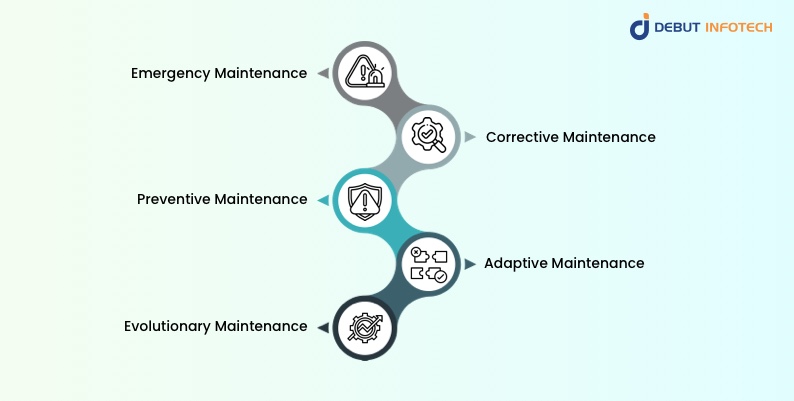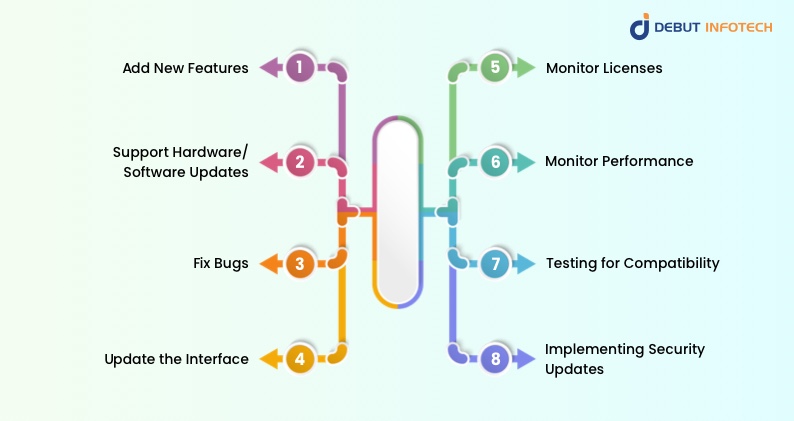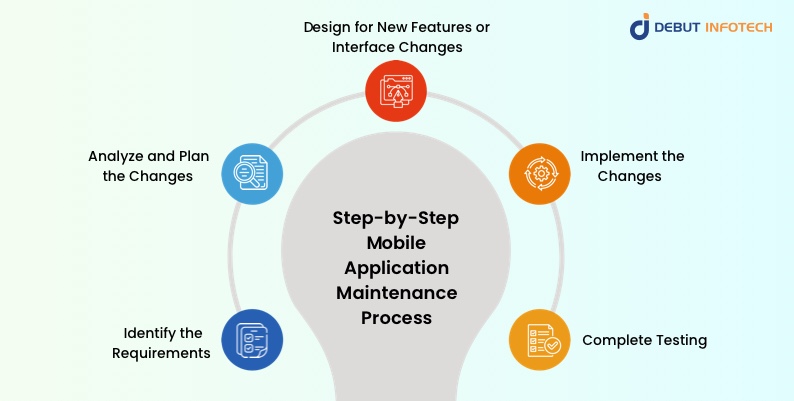Table of Contents
Home / Blog / Mobile Development
Mobile Application Maintenance: Why It Is A Vital Factor for Success?
February 18, 2025

February 18, 2025
Mobile applications have become a vital aspect of modern business. In 2022, 92% of the time Android users worldwide spent on mobile was occupied by engaging with mobile apps and gaming.
But launching an app is only half the battle; constant maintenance is essential for performance, security, and user retention. The latest data show that the average app will lose 77% of its daily active users within three days of installation. Within 30 days, this number increases to 90%, and by 90 days, over 95% of users have stopped using the app. This shows the importance of regular mobile app maintenance to retain users and ensure long-term success.
Regular updates, bug fixes, and security enhancements keep apps functional and competitive in an ever-changing digital landscape. Without proper maintenance, even the most successful apps risk becoming obsolete.
In this article, we will discuss the different types of mobile application maintenance, why it’s essential, and how businesses can sustain their app’s long-term success.
Keep Your App Running Smooth—We’ve Got Your Back!
Don’t let bugs or outdated features slow you down. Our expert team handles everything from consistent updates to performance tweaks. Let’s keep your app fast, fresh, and flawless.
What Is Mobile App Maintenance?
Mobile application maintenance is an ongoing process of updating, monitoring, and improving an application after its launch. This ensures that the app works properly, is supported by new devices and operating systems, and provides a seamless experience for users. Regular maintenance resolves security vulnerabilities, performance issues, and feature enhancements. This plays a role in making the app live longer.
What Are the Types of Mobile App Maintenance?

Here are the major different kinds of mobile application maintenance:
1. Emergency Maintenance
Emergency maintenance should be performed when urgent concerns impede the app’s deployment. These could be server failures, security breaches, or critical bugs, which make the app unusable. Immediate action is required to restore operations, prevent data loss, and minimize downtime so that users can continue accessing the app without any major disruptions.
2. Corrective Maintenance
Corrective maintenance is a maintenance process that aims to fix defects, malfunctions, or errors detected after the project launch. The issues can be due to coding errors, hardware malfunction , or software conflicts. Quickly addressing these ensures the app will run more stable, users will be more satisfied, and will limit problems that could affect the overall app function and reliability.
3. Preventive Maintenance
Preventive maintenance is an approach that involves taking proactive steps to identify and address probable problems before they impact users. This includes performance monitoring, security patches, and system optimizations. By preventing breakdowns, this type of maintenance leads to stability in the long term. It ensures that the costs of repairs incurred due to the app crashing are less. Also, it ensures that the app continues to work seamlessly across various devices and operating systems.
4. Adaptive Maintenance.
Adaptive maintenance ensures the app remains compatible with evolving technologies, such as new operating system versions, updated third-party integrations, and regulatory changes. This type of mobile app maintenance service involves modifying code, reconfiguring settings, or redesigning features to align with new technical standards, ensuring continued functionality and an optimal user experience across various platforms.
5. Evolutionary Maintenance
Evolutionary mobile application maintenance focuses on continuous app improvements, incorporating new features and enhancements based on user feedback and market trends. This type of maintenance ensures the app remains competitive, engaging, and aligned with user needs, fostering long-term growth and keeping it relevant in an ever-changing digital environment.
5 Reasons Why Maintenance of Mobile Apps Is Crucial
1. Mobile Application Maintenance Actually Saves You Money
Regular maintenance prevents costly emergency repairs by addressing minor issues before they escalate. In mobile app development, a neglected app may develop critical failures requiring extensive fixes, leading to higher expenses. Proactively updating software, optimizing performance, and resolving bugs ensure long-term cost savings, protecting your investment while maintaining smooth functionality for users.
2. Maintenance Keeps Your App Secure
Cyber threats are constantly evolving, and outdated apps become prime targets for attacks. Regular security updates, vulnerability patches, and encryption enhancements help protect user data and prevent breaches. Ensuring compliance with the latest security standards reduces risks, enhances trust, and safeguards both business reputation and customer information.
3. Regular Maintenance Keeps You Competitive
The mobile app market is highly dynamic, with new technologies, features, and user preferences constantly emerging. Failing to update an app can result in losing users to competitors offering better performance and modernized features. Ongoing mobile application maintenance allows businesses to stay ahead, refine user experience, and meet evolving market expectations.
4. Maintenance Lets You Stay Relevant
As user behavior and industry trends change, apps must adapt to stay relevant and engaging. Regular updates ensure compatibility with new devices, operating systems, and technological advancements. Without proper maintenance, an app risks becoming outdated, leading to decreased downloads, lower engagement rates, and potential removal from app stores.
5. Maintenance Helps You Comply With App Store Rules
App stores regularly revise their policies, which the developers must follow in terms of security, performance, and content guidelines. Failure to comply risks rejection or removal from app stores, harming visibility and revenue. Regular maintenance of the app helps you ensure that everything is up to the mark in any aspect, and you can be free from interruptions and still be high in digital stores.
Benefits of Mobile App Maintenance
Here are some benefits of mobile application maintenance:
1. Enhanced User Experience
With regular updates, the app continues to be intuitive, visually attractive, and responsive whenever a new version is released. Eliminating bugs, enhanced navigation, and optimized loading speeds play a part in offering clients a smoother experience. These potentially satisfied users are more likely to use the app, leave positive reviews, and recommend the app to others, leading to higher overall adoption.
2. Increased User Retention
No one is sticking around to use broken, slow, or stale applications. Regular maintenance ensures the app remains functional, secure, and in line with changing user preferences.
By regularly introducing improvements, top mobile software companies enhance engagement, encouraging users to continue using the app instead of switching to competitors offering better performance or new features.
3. Financial Impact
A well-maintained app reduces unexpected costs related to emergency fixes, security breaches, or lost revenue due to downtime. Regular maintenance helps sustain monetization strategies, such as in-app purchases or ads, ensuring steady income. Preventative maintenance also minimizes major disruptions, protecting long-term financial stability and business growth.
4. Maintained Brand Reputation
An app reflects a company’s reliability and commitment to quality. Frequent crashes, security vulnerabilities, or outdated interfaces can harm a brand’s image. Keeping the app updated, secure, and user-friendly reinforces trust, strengthens brand loyalty, and ensures that users associate the app with professionalism and high standards.
5. Better Productivity
Efficient mobile application maintenance services support seamless business operations, reducing time spent on troubleshooting and emergency fixes. Developers and support teams can focus on innovation rather than crisis management. A stable app also enhances workflow automation, improving productivity for businesses that rely on mobile applications for customer interactions or internal processes.
6. Higher Rankings in App Stores
Frequent updates signal app store algorithms that an app is actively maintained and valuable to users. Apps with consistent improvements and positive user engagement are more likely to rank higher in search results. This increased visibility attracts more downloads, helping businesses expand their reach and market presence.
7. Increases Life Span of the App
Apps that receive consistent updates remain functional for years, adapting to changing technology and user needs. Without mobile application maintenance, an app can quickly become obsolete, leading to decreased user interest and eventual removal from app stores. Long-term maintenance ensures the app remains relevant, profitable, and aligned with industry advancements.
Ways to Maintain a Mobile Application

Here is how to maintain an app:
1. Add New Features
Regularly introducing new features keeps the app engaging and relevant to users. Feature updates based on user feedback and market trends improve functionality, enhance the user experience, and increase retention. Businesses that continuously innovate ensure their apps stay competitive and appealing in an evolving digital landscape.
2. Support Hardware/Software Updates
Mobile devices and operating systems receive frequent updates, which can affect app performance. Ensuring compatibility with the latest hardware and software versions prevents crashes, glitches, or performance lags. Adapting the app to new technologies, such as 5G or AI-driven functionalities, also enhances usability and future-proofs the application.
3. Fix Bugs
Even well-developed apps encounter bugs that impact usability and stability. Identifying and fixing glitches through continuous monitoring ensures smooth functionality. As part of the app development process, minor issues must be addressed promptly, as ignoring them can escalate into major problems, leading to user frustration and drop-offs. Regular bug fixes enhance performance and reinforce trust in the app’s reliability.
4. Update the Interface
User expectations and design trends evolve, making periodic UI/UX updates essential. Enhancing navigation, optimizing layouts, and improving accessibility ensure a seamless user experience. A modernized, intuitive interface boosts engagement and encourages longer app sessions, reinforcing brand credibility and maintaining a visually appealing, easy-to-use platform.
5. Monitor Licenses
Many apps rely on third-party APIs, frameworks, or licensed software components. Keeping track of license expirations and renewals prevents service disruptions and compliance issues. Monitoring changes in third-party terms ensures continued functionality. It protects the app from potential legal risks or unexpected feature losses.
6. Monitor Performance
Performance tracking helps identify slowdowns, crashes, or resource-heavy processes that may affect usability. Analyzing key performance indicators (KPIs) such as load times, error rates, and server response speeds allows for timely optimizations. Addressing performance bottlenecks improves efficiency, enhances user satisfaction, and supports overall app stability—critical factors in mobile app monetization, where user retention and engagement directly impact revenue.
7. Testing for Compatibility
Compatibility testing ensures the app functions correctly across different devices, screen sizes, and operating systems. As mobile ecosystems expand, testing against various configurations prevents usability issues. Regular testing minimizes technical failures, ensuring that all users, regardless of device type, experience a seamless and consistent app experience.
8. Implementing Security Updates
Cyber threats constantly evolve, making security updates a top priority. Regular patches address vulnerabilities, prevent data breaches, and comply with regulatory standards. Strengthening encryption, updating authentication methods, and safeguarding sensitive data ensure user trust and protect businesses from security-related liabilities and reputational damage.
Step-by-Step Mobile Application Maintenance Process

Here is a step-by-step guide on how to run app maintenance:
1. Identify the Requirements
The first step in app maintenance is assessing what needs to be updated or fixed. This involves gathering user feedback, analyzing performance data, and identifying security vulnerabilities. A top-rated mobile app development company follows this approach to ensure updates address real issues, improve functionality, and enhance the overall user experience without unnecessary changes.
2. Analyze and Plan the Changes
Once the requirements are identified, developers must evaluate their impact and feasibility. This stage involves prioritizing tasks, estimating costs, and defining a timeline. A well-structured plan ensures that updates are implemented efficiently, preventing disruptions while aligning changes with business objectives and user expectations.
3. Design for New Features or Interface Changes
If the update involves new features or UI enhancements, a proper design phase is essential. Developers and designers create wireframes, prototypes, or mockups to visualize improvements. Ensuring seamless integration with existing functionalities minimizes disruption, improves user interaction, and keeps the app modern and competitive.
4. Implement the Changes
After finalizing the design, developers proceed with coding and integrating the updates. This step requires rigorous version control, adherence to coding best practices, and the minimization of downtime. The efficient implementation ensures smooth functionality, maintains performance, and prevents unintended issues from affecting users—an essential factor for mobile app investors seeking reliability and long-term success.
5. Complete Testing
Before releasing updates, comprehensive testing is necessary to identify and resolve potential issues. This includes functionality, security, compatibility, and performance testing across different devices and operating systems. A thorough testing phase prevents crashes, ensures smooth user experiences, and guarantees that the new version meets all quality standards.
Factors That Affect App Maintenance Costs
Here are some factors influencing app maintenance costs:
1. App Size & Complexity
Larger and more complex apps require extensive maintenance due to multiple features, integrations, and backend processes. Besides mobile app development cost, advanced functionalities like AI, real-time processing, or third-party API connections increase costs. More code means more potential bugs, necessitating regular updates, performance optimizations, and security patches to ensure smooth and efficient operation.
2. User Base
Apps with a large user base demand higher maintenance efforts. More users generate more data, increasing server costs, security risks, and the need for frequent optimizations. High-traffic apps require scalable infrastructure or mobile app development frameworks, real-time monitoring, and efficient bug resolution to prevent downtime and maintain a seamless experience across different devices and locations.
3. Update Frequency
Frequent updates ensure an app remains functional and competitive but also increase maintenance expenses. Some apps require monthly or even weekly updates for security patches, UI improvements, or new features. The more frequent the updates, the higher the costs for development, testing, and deployment, especially for apps operating across multiple platforms.
4. Platform & Operating System
Supporting multiple platforms, such as iOS and Android, increases maintenance costs. Each operating system has unique requirements, updates, and compatibility issues that require constant monitoring. Additionally, maintaining older versions of an app for legacy device users adds complexity, requiring more resources to ensure consistent performance across different OS versions and devices.
Tired of App Headaches? We Make Maintenance Easy
No more worrying about glitches or slowdowns. Our team ensures your app is always running smoothly and staying future-ready. Let’s make your app unstoppable.
Conclusion
Mobile application maintenance is not just an optional afterthought—it is integral for long-term success. Application maintenance leads to increased security, provides a good user experience, and helps businesses to be competitive in the digital market. Apps that are not updated regularly risk getting breaches on security, getting lower in rankings, and lower user engagement.
Ongoing maintenance protects that investment but also builds a community of users and enhances the lifetime of the app. Whether through feature updates, performance monitoring, or security patches, consistent maintenance ensures that an app remains functional, secure, and relevant for years to come.
FAQs
App maintenance is ongoing—it never really stops. Some updates take hours, while bigger ones can stretch over weeks. Bug fixes are quick, but security patches and feature upgrades need more time. It all depends on your app’s complexity, user feedback, and how often you want to roll out updates.
Absolutely. Many businesses outsource app maintenance to save time and costs. A reliable third-party provider can handle bug fixes, updates, security patches, and performance improvements. Just make sure they understand your app, users, and long-term goals so they can keep everything running smoothly without disrupting the user experience.
Costs vary based on the app’s complexity, update frequency, and required support. Basic maintenance can be a few hundred dollars monthly, while larger apps with frequent updates might cost thousands. If you need round-the-clock support or major upgrades, expect higher expenses. Budgeting 15–20% of development costs yearly is a good rule.
Not always, but it helps. If your app is complex or mission-critical, a dedicated team ensures fast fixes, security updates, and new features. For smaller apps, periodic check-ins from a maintenance provider may be enough. The key is having someone on standby to keep everything running.
Start with critical fixes—bugs, crashes, and security vulnerabilities come first. Then, focus on performance improvements and compatibility updates. After that, roll out new features based on user feedback. Keeping an eye on analytics helps, too, so you can address issues before they become bigger problems.
Talk With Our Expert
USA
2102 Linden LN, Palatine, IL 60067
+1-703-537-5009
[email protected]
UK
Debut Infotech Pvt Ltd
7 Pound Close, Yarnton, Oxfordshire, OX51QG
+44-770-304-0079
[email protected]
Canada
Debut Infotech Pvt Ltd
326 Parkvale Drive, Kitchener, ON N2R1Y7
+1-703-537-5009
[email protected]
INDIA
Debut Infotech Pvt Ltd
C-204, Ground floor, Industrial Area Phase 8B, Mohali, PB 160055
9888402396
[email protected]




Leave a Comment